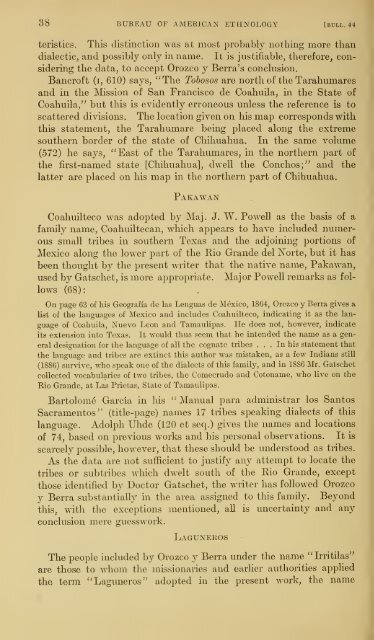Untitled - Smithsonian Institution
Untitled - Smithsonian Institution
Untitled - Smithsonian Institution
You also want an ePaper? Increase the reach of your titles
YUMPU automatically turns print PDFs into web optimized ePapers that Google loves.
38 BUREAU OF AMERICAN ETHNOLOGY [bull. 44<br />
teristics. This distinction was at most probably nothing more than<br />
dialectic, and possibly only in name. It is justifiable, therefore, con-<br />
sidering the data, to accept Orozco y Berra's conclusion.<br />
Bancroft (i, 610) says, "The Tohosos are north of the Tarahumares<br />
and in the Mission of San Francisco de Coahuila, in the State of<br />
Coahuila," but this is evidently erroneous unless the reference is to<br />
scattered divisions. The location given on his map corresponds with<br />
this statement, the Tarahumare being placed along the extreme<br />
southern border of the state of Chihuahua. In the same volume<br />
(572) he says, ''East of the Tarahumares, in the northern part of<br />
the first-named state [Chihuahua], dwell the Conchos;" and the<br />
latter are placed on his map in the northern part of Chihuahua.<br />
Pakawan<br />
Coahuilteco was adopted by Maj. J. W. Powell as the basis of a<br />
family name, Coahuiltecan, wliich appears to have included numer-<br />
ous small tribes in southern Texas and the adjoining portions of<br />
Mexico along the lower part of the Kio Grande del Norte, but it has<br />
been thought by the present writer that the native name, Pakawan,<br />
used by Gatschet, is more appropriate. Major Powell remarks as fol-<br />
lows (68):<br />
On page 63 of his Geografia de las Lenguas de Mexico, 1864, Orczco y Berra gives a<br />
list of the languages of Mexico and includes Coahuilteco, indicating it as the lan-<br />
guage of Coahuila, Nuevo Leon and Tamaulipas. He does not, however, indicate<br />
its extension into Texas. It would thus seem that he intended the name as a gen-<br />
eral designation for the language of all the cognate tribes ... In his statement that<br />
the language and tribes are extinct this author was mistaken, as a few Indians still<br />
(1886) survive, who speak one of the dialects of this family, and in 1886 Mr. Gatschet<br />
collected vocabularies of two tribes, the Comecrudo and Cotoname, who live on the<br />
Rio Grande, at Las Prietas, State of Tamaulipas.<br />
Bartolome Garcia in his " Manual para administrar los Santos<br />
Sacramentos" (title-page) names 17 tribes speaking dialects of this<br />
language. Adolph Uhde (120 et seq.) gives the names and locations<br />
of 74, based on previous works and his j)ersonal observations. It is<br />
scarcely possible, however, that these should be understood as tribes.<br />
As the data are not sufficient to justify any attempt to locate the<br />
tribes or subtribes wliich dwelt south of the Rio Grande, except<br />
those identified by Doctor Gatschet, the writer has followed Orozco<br />
y Berra substantially in the area assigned to this family. Beyond<br />
this, with the exceptions mentioned, aU is uncertainty and any<br />
conclusion mere guesswork,<br />
Laguneros<br />
The people included by Orozco y Berra under the name "Irritilas"<br />
are those to whom the missionaries and earlier authorities applied<br />
the term "Laguneros" adopted in the present work, the name

















